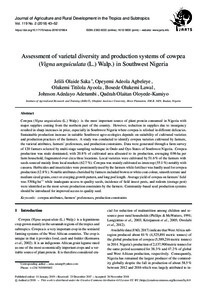| dc.date.accessioned | 2019-01-17T08:40:03Z | |
| dc.date.available | 2019-01-17T08:40:03Z | |
| dc.date.issued | 2019-01-11 | |
| dc.identifier | doi:10.17170/kobra-2018121864 | |
| dc.identifier.uri | http://hdl.handle.net/123456789/11027 | |
| dc.description | Gedruckte Ausg. im Verlag Kassel Univ. Press (www.upress.uni-kassel.de) erschienen. | ger |
| dc.language.iso | eng | |
| dc.publisher | Kassel University Press | |
| dc.rights | Urheberrechtlich geschützt | |
| dc.rights.uri | https://rightsstatements.org/page/InC/1.0/ | |
| dc.subject | cowpea attributes | eng |
| dc.subject | farmers’ preferences | eng |
| dc.subject | production constraints | eng |
| dc.subject.ddc | 630 | |
| dc.title | Assessment of varietal diversity and production systems of cowpea (Vigna unguiculata (L.) Walp.) in Southwest Nigeria | eng |
| dc.type | Aufsatz | |
| dcterms.abstract | Cowpea (Vigna unguiculata (L.) Walp.) is the most important source of plant protein consumed in Nigeria with major supplies coming from the northern part of the country. However, reduction in supplies due to insurgency resulted in sharp increases in price, especially in Southwest Nigeria where cowpea is relished in different delicacies. Sustainable production increase in suitable Southwest agro-ecologies depends on suitability of cultivated varieties and production practices of the farmers. A study was conducted to identify cowpea varieties cultivated by farmers, the varietal attributes, farmers’ preferences, and production constraints. Data were generated through a farm survey of 120 farmers selected by multi-stage sampling technique in Ondo and Oyo States of Southwest Nigeria. Cowpea production was male dominated, with 20.8 % of cultivated area allocated to its production, averaging 0.96 ha per farm household, fragmented over circa three locations. Local varieties were cultivated by 51.6 % of the farmers with seeds sourced mainly from local markets (62.7 %). Cowpea was mainly cultivated as intercrop (55.1 %) notably with cassava. Herbicides and insecticides were prominently used by the farmers while fertiliser was hardly used for cowpea production (12.8 %). Notable attributes cherished by farmers included brown or white coat colour, smooth texture and medium sized grains, erect or creeping growth pattern, and long pod length. Average yield of cowpea on farmers’ field was 530 kg ha−1 while inadequate access to quality seeds, incidence of field insect pests, and rodents (storage pest) were identified as the most severe production constraints by the farmers. Community-based seed production systems should be introduced for improved access to quality seed. | eng |
| dcterms.accessRights | open access | |
| dcterms.creator | Saka, Jelili Olaide | |
| dcterms.creator | Agbeleye, Opeyemi Adeola | |
| dcterms.creator | Ayoola, Olukemi Titilola | |
| dcterms.creator | Lawal, Bosede Olukemi | |
| dcterms.creator | Adetumbi, Johnson Adedayo | |
| dcterms.creator | Oloyede-Kamiyo, Qudrah Olaitan | |
| dc.type.version | publishedVersion | |
| dcterms.source.identifier | 1612-9830 | |
| dcterms.source.identifier | 2363-6033 | |
| dcterms.source.issue | No. 2 | |
| dcterms.source.journal | Journal of Agriculture and Rural Development in the Tropics and Subtropics (JARTS) | eng |
| dcterms.source.pageinfo | 43-52 | |
| dcterms.source.volume | Vol. 119 | |

